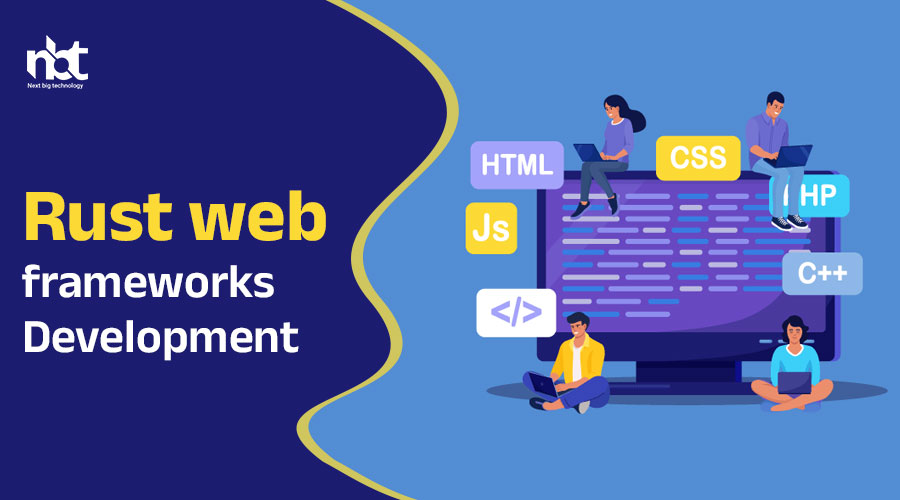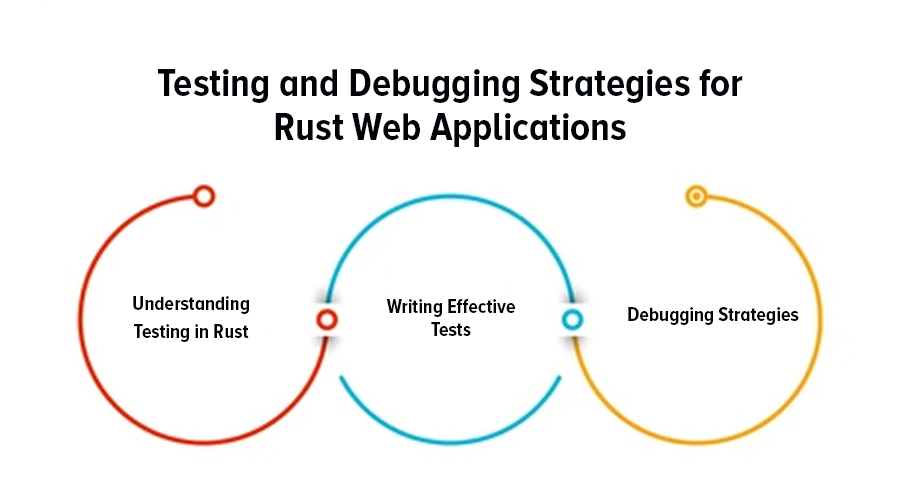Table of Contents
Introduction to Rust Web Frameworks
In the ever-evolving landscape of web development, choosing the right framework is crucial for building robust, scalable, and efficient web applications. With the emergence of Rust as a language celebrated for its performance, safety, and concurrency features, it’s no surprise that Rust web frameworks are gaining traction among developers worldwide.
Rust, known for its emphasis on memory safety without sacrificing performance, has become a popular choice for systems programming. However, its adoption in web development has been relatively recent, yet promising. Rust web frameworks leverage the language’s strengths to empower developers to build secure, blazing-fast web applications.
Understanding Rust Web Frameworks
Rust web frameworks provide developers with the tools and abstractions necessary to streamline web development processes. These frameworks offer a range of features, including routing, middleware support, templating engines, and database integration, allowing developers to focus on building functionality rather than dealing with low-level details.
Key Rust Web Frameworks:
- Actix Web: Actix Web stands out as one of the fastest and most lightweight Rust web frameworks. Built on top of Actix, a powerful actor framework, Actix Web boasts exceptional performance and scalability. With its asynchronous architecture, Actix Web enables handling thousands of concurrent connections with ease.
- Rocket: Rocket is a web framework for Rust that prioritizes simplicity, ease of use, and safety. With its intuitive API and extensive documentation, Rocket allows developers to quickly build web applications without sacrificing performance or security. Rocket’s compile-time guarantees ensure memory safety and prevent common pitfalls associated with web development.
- Tide: Tide is a minimal and modular Rust web framework designed for flexibility and performance. Leveraging asynchronous programming paradigms, Tide enables building non-blocking web applications with ease. Its composable middleware architecture and intuitive API make it an excellent choice for developers seeking a lightweight yet powerful web framework.
- Warp: Warp is a fast, composable, and lightweight Rust web framework designed for building high-performance web services. With its declarative routing DSL and asynchronous request handling, Warp simplifies the process of building scalable web applications. Warp’s focus on ergonomics and performance makes it well-suited for a wide range of web development tasks.
Advantages of Rust Web Frameworks
- Performance: Rust web frameworks leverage the language’s performance characteristics to deliver blazing-fast web applications. With features such as asynchronous programming and zero-cost abstractions, Rust enables building highly optimized web services.
- Safety: Rust’s emphasis on memory safety and thread safety translates into more secure web applications. Rust’s strict compiler ensures memory safety at compile time, reducing the risk of common security vulnerabilities such as buffer overflows and memory leaks.
- Concurrency: Rust’s concurrency model enables building highly concurrent web applications without the complexity associated with traditional threading models. Asynchronous programming paradigms, supported by Rust web frameworks, allow handling thousands of concurrent connections with ease.
- Scalability: Rust web frameworks are designed with scalability in mind, allowing developers to build web applications that can handle high loads and scale effortlessly. With features such as asynchronous request handling and lightweight concurrency primitives, Rust web frameworks enable building scalable web services with ease.
Choosing the Right Rust Web Framework for Your Project
In the expansive realm of web development, choosing the right framework can be akin to selecting the perfect tool for a craftsman. Each project comes with its own unique set of requirements, and finding the ideal Rust web framework to match those needs is crucial for success. With Rust gaining momentum for its performance, safety, and concurrency features, developers are increasingly turning to this language for their web projects. But with several frameworks available, where does one begin?
Understanding Your Project Needs
Before diving into the plethora of Rust web frameworks, it’s essential to understand the specific requirements of your project. Consider factors such as scalability, performance, ease of use, community support, and the nature of your application. Are you building a small, lightweight API or a robust, feature-rich web application? Understanding these parameters will help narrow down your options.
Exploring the Rust Ecosystem
Rust’s ecosystem boasts several web frameworks, each with its own strengths and weaknesses. Let’s delve into some of the prominent ones:
1. Rocket: Rocket stands out for its intuitive syntax and comprehensive features, making it an excellent choice for developers familiar with Rust. It offers robust routing, powerful request handling, and seamless integration with asynchronous programming through its async support. Rocket’s type-safe routing and compile-time guarantees ensure safety and reliability, albeit with a steeper learning curve for beginners.
2. Actix Web: Actix Web shines in terms of performance and scalability, leveraging Rust’s asynchronous capabilities for high-concurrency applications. It boasts minimal overhead and exceptional throughput, making it ideal for projects requiring maximum efficiency. Actix Web’s actor-based architecture enables seamless handling of thousands of connections concurrently, making it a top choice for performance-critical applications.
3. Tide: Tide is known for its simplicity and composability, offering a lightweight yet powerful framework for building web applications. Built on top of asynchronous Rust, Tide provides a familiar and ergonomic API while prioritizing safety and performance. Its modular design allows developers to mix and match components according to their project requirements, offering flexibility without sacrificing efficiency.
Evaluating Trade-offs
When choosing a Rust web framework, it’s crucial to weigh the trade-offs between features, performance, and ease of use. Consider factors such as documentation quality, community support, ecosystem maturity, and long-term maintenance. Additionally, assess how well the framework aligns with your team’s expertise and project goals.
Getting Started with Rust Web Development
Rust, the fast-growing programming language, has been making waves in the tech community for its unparalleled performance, safety, and concurrency. While it’s renowned for system programming, its capabilities extend far beyond. Today, we embark on a journey to explore Rust’s prowess in web development, offering insights and guidance to get you started on this exciting path.
Understanding Rust: Before diving into web development with Rust, let’s grasp its core principles. Rust combines the performance of low-level languages like C and C++ with the safety and memory management of high-level languages like Python and JavaScript. Its strict compiler ensures memory safety, preventing common bugs like null pointer dereferencing and data races.
Setting Up Your Environment: To begin your Rust web development journey, you need to set up your development environment. Start by installing Rust and Cargo, Rust’s package manager, using Rustup. This ensures you have the latest stable version of Rust and access to essential tools for building and managing your projects.
Choosing the Right Framework: Rust boasts several frameworks tailored for web development, each with its strengths and use cases. Rocket, Actix, and Warp are among the popular choices, offering robust features for building high-performance web applications. Consider your project requirements, such as speed, scalability, and ease of use, when selecting a framework.
Creating Your First Web Application: With your environment configured and framework chosen, it’s time to dive into building your first Rust web application. Start by initializing a new project using Cargo and your preferred framework’s templates. This sets up the necessary directory structure and files to kickstart your development process.
Exploring Key Concepts: As you delve deeper into Rust web development, familiarize yourself with key concepts such as routing, middleware, and templating. Routing enables you to define endpoints and handle incoming requests, while middleware allows for preprocessing requests or modifying responses. Templating engines like Tera or Handlebars facilitate dynamic content generation, enhancing the user experience.
Handling Asynchronous Operations: Rust excels in handling asynchronous operations, crucial for building responsive web applications. Leveraging Rust’s async/await syntax and asynchronous libraries like Tokio or async-std, you can efficiently manage concurrent tasks without sacrificing performance. This enables handling multiple requests concurrently, ensuring optimal responsiveness.
Testing and Debugging: Testing is integral to ensuring the reliability and stability of your Rust web application. Utilize Rust’s built-in testing framework and libraries like assert to write comprehensive test suites covering various scenarios. Additionally, leverage debugging tools like Rust’s built-in debugger or third-party utilities to identify and resolve issues efficiently.
Optimizing Performance: Performance optimization is a continuous process in web development, and Rust provides powerful tools to streamline your application’s performance. Utilize profiling tools like perf or FlameGraph to identify performance bottlenecks and optimize critical code paths. Additionally, leverage Rust’s zero-cost abstractions and efficient memory management to maximize performance without sacrificing safety.
Deploying Your Application: Once your Rust web application is polished and tested, it’s time to deploy it to a production environment. Consider deploying to platforms like AWS, Heroku, or DigitalOcean, leveraging their infrastructure and deployment tools. Ensure to configure your application for security, scalability, and reliability, implementing best practices to safeguard against common vulnerabilities.
Exploring the Architecture of Rust Web Frameworks
In the realm of web development, choosing the right framework can often feel like navigating a labyrinth of options. However, for those seeking a robust, performant, and safe environment, Rust web frameworks stand out as shining beacons of innovation. Renowned for their focus on speed, safety, and concurrency, Rust frameworks offer a tantalizing glimpse into the future of web development. Let’s embark on a journey to explore the architectural wonders of these frameworks, unraveling their inner workings and understanding what makes them truly exceptional.
The Foundation: Rust’s Core Principles At the heart of Rust’s appeal lies its core principles of safety, speed, and concurrency. Unlike many other languages, Rust enforces strict compile-time checks, eliminating entire classes of bugs such as null pointer dereferencing and data races. This emphasis on safety permeates through Rust web frameworks, instilling developers with confidence in their code’s integrity.
Actix: Where Performance Meets Simplicity Actix stands as a testament to Rust’s prowess in the realm of web development. Built on top of Tokio, a popular asynchronous runtime for Rust, Actix excels in handling thousands of concurrent connections with ease. Its actor-based architecture promotes a highly concurrent and scalable design, making it a favorite among developers seeking performance without sacrificing simplicity.
Rocket: Embracing Rust’s Expressiveness Rocket, another prominent Rust web framework, distinguishes itself through its expressive and ergonomic design. Leveraging Rust’s powerful macros and type system, Rocket empowers developers to write concise yet expressive code, reducing boilerplate and enhancing productivity. With its intuitive routing system and comprehensive request handling capabilities, Rocket simplifies the development of complex web applications without compromising on performance.
Warp: Unleashing the Power of Functional Programming For aficionados of functional programming, Warp emerges as a compelling choice. Built on top of the powerful hyper HTTP library, Warp embraces functional programming paradigms to provide a composable and extensible framework for building web services. Its declarative routing and filter-based middleware system enable developers to construct elegant and efficient web applications, leveraging the full expressive power of Rust.
Tide: The Next Generation of Asynchronous Web Frameworks Tide represents the cutting edge of asynchronous web frameworks in the Rust ecosystem. Inspired by JavaScript’s Express.js, Tide offers a familiar and intuitive API for building asynchronous web applications in Rust. With its lightweight yet powerful architecture, Tide caters to developers seeking a modern and flexible framework for building high-performance web services.
Data Management and Persistence in Rust Web Applications
In the dynamic landscape of web development, Rust has emerged as a powerful language choice due to its performance, safety, and expressive syntax. However, crafting robust web applications in Rust entails more than just mastering its syntax; it requires a deep understanding of data management and persistence. In this article, we delve into the intricacies of handling data and ensuring persistence in Rust web applications.
Understanding Data Management
Data management lies at the core of any web application. In Rust, managing data effectively involves leveraging its strong type system and ownership model. Rust’s ownership system ensures memory safety without the need for a garbage collector, making it ideal for high-performance applications.
When designing data models for Rust web applications, defining clear struct representations is crucial. Structs encapsulate data and behavior, providing a clean and structured way to manage information. Leveraging Rust’s enums and traits further enhances data modeling capabilities, enabling developers to represent complex data structures efficiently.
Persistence Mechanisms in Rust
Persistence is essential for storing and retrieving data across sessions in web applications. Rust offers several mechanisms for achieving persistence, each suited to different use cases:
- Embedded Databases: For lightweight applications, embedded databases like SQLite offer a convenient solution. Rust provides robust bindings to SQLite, enabling seamless integration into web applications. With SQLite, data can be stored locally in a single file, simplifying deployment and management.
- ORMs (Object-Relational Mapping): ORMs such as Diesel provide an abstraction layer for interacting with databases in Rust. By mapping Rust structs to database tables and abstracting SQL queries, ORMs streamline database operations and enhance code readability. Diesel’s type-safe query builder ensures compile-time safety, reducing the likelihood of runtime errors.
- NoSQL Databases: For applications requiring flexible schema designs and horizontal scalability, NoSQL databases like MongoDB are a popular choice. Rust boasts robust MongoDB drivers, enabling seamless integration with web applications. With BSON (Binary JSON) support, Rust developers can work with MongoDB’s document-oriented model efficiently.
Best Practices for Data Management and Persistence
While Rust empowers developers with powerful tools for data management and persistence, adhering to best practices is essential for building reliable web applications:
- Error Handling: Rust’s Result and Option types facilitate robust error handling. Properly handling errors ensures graceful recovery from failures, enhancing application resilience.
- Transaction Management: When dealing with database operations, transaction management is crucial for maintaining data integrity. Rust’s support for transactions ensures atomicity and consistency, safeguarding against data corruption.
- Performance Optimization: Leveraging Rust’s zero-cost abstractions and advanced compiler optimizations, developers can optimize data access and manipulation for maximum performance.
- Security Considerations: Implementing proper authentication and authorization mechanisms protects sensitive data from unauthorized access. Rust’s strong type system mitigates common security vulnerabilities such as SQL injection and buffer overflows.
Middleware and Plug-ins in Rust Web Frameworks
In the dynamic world of web development, where speed, efficiency, and scalability are paramount, Rust has emerged as a formidable player. Renowned for its safety, performance, and concurrency, Rust is gaining traction in the web development landscape, thanks in part to its robust web frameworks. Among the arsenal of tools available to Rust developers, middleware and plug-ins stand out as essential components for crafting powerful and extensible web applications.
Understanding Middleware: Middleware acts as a bridge between the client and the server, intercepting and processing requests and responses. In Rust web frameworks, middleware plays a crucial role in executing tasks such as authentication, logging, error handling, and request preprocessing. By integrating middleware into the request-response cycle, developers can modularize their codebase, enhance security, and improve the overall reliability of their applications.
One of the key advantages of middleware is its ability to encapsulate common functionalities, enabling developers to focus on building core features without reinventing the wheel. For instance, middleware for authentication can verify user credentials, enforce access control policies, and generate tokens, thereby simplifying the implementation of authentication mechanisms in Rust web applications.
Harnessing the Power of Plug-ins: Plug-ins extend the functionality of web frameworks by introducing additional features and capabilities. In Rust, plug-ins are typically designed as reusable components that can be easily integrated into web applications. Whether it’s adding support for database interactions, caching, or session management, plug-ins empower developers to customize and extend the functionality of their web applications with minimal effort.
Plug-ins in Rust web frameworks adhere to the principle of modularity, allowing developers to mix and match components based on their specific requirements. This flexibility not only accelerates development but also fosters code reuse and maintainability. Moreover, plug-ins facilitate collaboration within the Rust community, as developers can share and contribute to a growing ecosystem of reusable components and libraries.
Popular Middleware and Plug-ins in Rust Web Frameworks: Several Rust web frameworks offer robust support for middleware and plug-ins, enabling developers to leverage a rich set of functionalities to build scalable and performant web applications. For example, Rocket, a web framework for Rust, provides a comprehensive middleware system that enables developers to seamlessly integrate middleware into their applications. From CORS handling to request logging, Rocket’s middleware ecosystem simplifies common web development tasks and promotes code consistency.
Similarly, Actix Web, another popular Rust web framework, offers a powerful plug-in system that allows developers to extend the framework’s capabilities with ease. Whether it’s integrating with WebSocket protocols, implementing rate limiting, or adding support for JSON Web Tokens (JWT), Actix Web’s plug-in architecture empowers developers to tailor their applications to meet specific requirements.
Authentication and Authorization in Rust Web Development
In the realm of web development, security stands as an imperious sentinel, guarding against unauthorized access and ensuring the integrity of user data. In this digital age, where data breaches loom large, mastering authentication and authorization mechanisms is paramount for any developer venturing into the Rust ecosystem.
Rust, with its emphasis on safety and performance, offers a robust framework for web development. However, understanding how to implement authentication and authorization effectively within Rust applications requires a nuanced approach.
Authentication, the process of verifying the identity of a user, forms the foundational layer of security. In Rust web development, this often involves leveraging libraries like actix-web or rocket alongside authentication middleware such as jsonwebtoken or oauth2 to handle user authentication.
Implementing authentication typically involves the following steps:
- User Registration: Providing endpoints to allow users to register by providing necessary credentials like username, email, and password.
- User Login: Creating endpoints to authenticate users by verifying their credentials against those stored in a database.
- Token Generation: Upon successful authentication, generating a token (JWT or OAuth2 token) containing necessary information such as user ID and expiration time.
- Token Verification: Utilizing middleware to intercept incoming requests, verify the authenticity of the token, and extract relevant user information.
Authorization, on the other hand, focuses on determining what actions a user is allowed to perform within the application. In Rust, this is often achieved through role-based access control (RBAC) or attribute-based access control (ABAC) mechanisms.
Key steps in implementing authorization include:
- Role Definition: Defining roles that encapsulate different levels of access within the application, such as admin, user, or guest.
- Authorization Middleware: Implementing middleware to intercept incoming requests, extract user roles or permissions from the token, and validate whether the user is authorized to perform the requested action.
- Resource Protection: Securing endpoints or resources by associating them with specific roles or permissions, ensuring that unauthorized users are barred from accessing sensitive functionalities.
In Rust web development, libraries such as guard, casbin, or rbac can facilitate the implementation of authorization logic, providing developers with the tools to enforce access control policies effectively.
Furthermore, integrating authentication and authorization seamlessly with other components of the application, such as database interactions and business logic, is crucial for building a secure and reliable web application in Rust.























